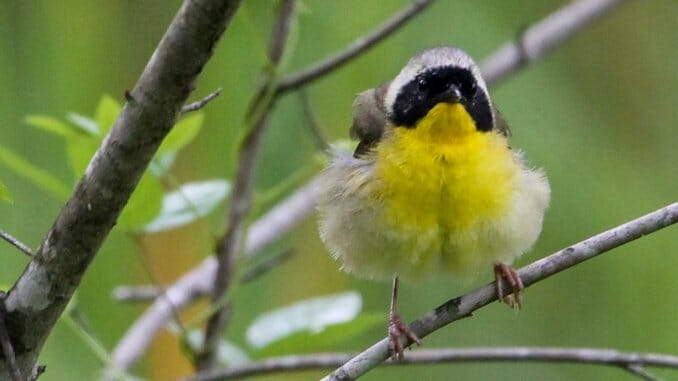Discovering Atlanta’s Abundant Nature Preserves Through Birding
Photos by Josh Jackson
Early this morning I took a three-mile walk around the Davidson-Arabia Mountain Nature Preserve, covering just a fraction of the 2,550-acre park. It’s taken a pandemic for me to discover just how many amazing pockets of wild Georgia exist within a 20-minute drive from my house. There’s Lullwater Preserve right next to Emory University, Clyde Shepherd Nature Preserve that literally abuts the North DeKalb Mall parking lot, Constitution Lakes with its wonderfully creepy folk-art installation Doll’s Head Trail, South Peach Creek Trail’s boardwalk overlooking the flowing waters, Friendship Forest Wildlife Sanctuary hidden just four miles away from me in Clarkston—not to mention all the cemeteries and parks around me which provide great places to look at birds.
And that’s what I’ve been doing during the Covid-19 shutdown, looking at birds. Birds outside my window while I work. Birds near my parents’ house in Beaufort, S.C. Birds in every one of the trails and parks mentioned above. Some have turned to gardening, baking sourdough bread, cooking or constantly scrolling through their social network of choice these last few months. I’ve been birding.
To be fair, I’d casually started noting what birds I was seeing on a trip to see family in South Carolina at the end of last year with the help of my older brother before the pandemic began. After launching a successful accounting firm and leaving that to become a missionary in Guatemala and Thailand, he kicked off his third career a few years ago as a biology professor and became the family naturalist, pointing out all the interesting birds and other animals living on the marsh where both he and my parents now live. I’ll admit a little jealousy when his return to grad school also involved two months in the Peruvian Amazon studying monkeys. I started the University of Georgia as a biology major before embracing my love of writing and switching to magazine journalism. I don’t regret that decision for a second as it led me to launch Paste magazine and the countless amazing experiences that followed. But I never abandoned my love of nature.
But I also never really embraced it where I lived.
Atlanta is one of the greenest cities in America. Even if your only experience with my hometown is flying in and out of Hartsfield-Jackson Airport, it’s even obvious from the skies. A canopy covers my city in a way I didn’t realize was unusual until I moved to the Midwest. One of the hardest things about living in Sioux Falls for just over three years (and four winters) was the lack of trees. But in Atlanta, even the greediest developers, sprawling suburbs and cult of corporate culture can’t put more than a few dents in the forest in which we live. This started to become apparent to me when a friend invited me on his neighborhood’s annual “Death March,” a 26-mile hike/pub crawl through the city, more than half of which was traversed on trails deep in the woods. I made a mental note to take advantage of my city’s wilder areas, but it would take a near-total shutdown of social gatherings and a newfound love of birding to make me actually do that.
It started innocently enough back in April with the purchase of a feeder for my backyard to hang outside the window in my bedroom that became my home office back in March. I learned to identify that one with the purplish head as a House Finch and the tiny black-and-white woodpecker as a Downy. I got excited when a family of Goldfinches appeared right outside my window and a flock of Cedar Waxwings descended upon the serviceberry tree near my house. I couldn’t imagine how much joy I’d get from the Northern Flicker hopping around my backyard for a few days in a row. I began tracking what I was seeing on the Cornell Lab of Ornithology’s eBird app, which not only acts as a personal checklist, but feeds the data to scientists tracking birds all over the world.
My one feeder became seven with different varieties of food, and I began to recognize the 38 different kinds of species that I’ve spotted in my small urban backyard—the tiny Chickadees, Wrens, Finches and Nuthatches; the larger Catbirds, Brown Thrashers and the Mockingbirds who would bully the others off; the beautiful Eastern Towhees digging through my woodchips to find worms to feed their awkward looking young; four different kinds of woodpeckers; Bluebirds and Blue Jays and a pair of Barred Owls barking back and forth like dogs; a Ruby-Throated Hummingbird who’s so far ignored the feeder that’s religiously refilled just for him. We’ve spent more time in our backyard in the last three months than we have in the prior three years we’ve lived in this house, and I can now tell most of them by sound as well as sight and have seen countless different fledglings learn the ropes from their parents during that short time.
When the stress of running a business in the time of Covid-19 made sleep difficult, I began getting up early on weekend mornings and picking a new birding “hotspot” on the app to explore. They never disappoint. Hiking through Metro Atlanta’s hidden trails is my only exercise right now except practicing socially distanced long passes with a few soccer teammates on Saturdays. And even there I find myself distracted by the birds around me, especially last weekend when two Eastern Kingbirds decided to perch atop each field goalpost behind me for an hour, diving periodically to snatch insects out of the air.
This morning’s hike near Arabia Mountain might have been the most enjoyable, though. There’s a trail for joggers through the woods, but the “path” I took opened immediately onto a granite outcropping, a wide-open space with views of the forest’s edge with an abundance of snags—or dead trees—perfect for finding birds. My eighth-grade biology field trips to Stone Mountain came rushing back, where we learned how first lichen would grow on the granite surface, followed by mosses, which would trap dirt blowing in the wind until you had more and more plants and eventually trees growing atop a giant rock. This was playing out all over the base of Arabia Mountain around me.
A few birds were reported here a couple of weeks ago that I’d never seen, including the Yellow-Breasted Chat, an unusual looking bird with a long tail, white and black stripes around its eyes and its bright namesake breast, who happens to have an equally unusual voice, a combination of staccato singing and squeaky-toy calls. It was the latter which caught my attention as I was walking on the past a small copse of trees in the middle of the Mile Rock Trail. I climbed up into the edge of the covert and spotted him (or her—both genders have that glorious coloration) almost immediately. She spotted me too, and continued to call out as if warning me not to come closer. I can acknowledge that it’s a little silly to get this excited about adding a new “lifer” to my birding tally, but I can also drop any pretense of cool and admit that I was thrilled to find a bird I’d been looking for, to see and hear it in person after scrolling past her entry in lists of possible birds for Georgia, to watch her flitting around the undergrowth, poking her pretty little head out of the brush.
Not long after, I heard another strange call, this time coming from the middle of the granite floor up ahead. It took me a minute to find the Killdeer, agitated and squawking in my direction. It took me another minute to see why—a tiny juvenile looking like an animated stuffed animal, too cute to be real. In the face of a potential predator, Killdeer will sometimes lay down and fold out a wing as if injured to distract the hunter from its young. I resisted the urge to get closer and see that dramatic performance in action, not wanting to upset mom anymore than I had. But take a minute to fully enjoy what a baby Killdeer looks like.

I saw deer and rabbits and 27 different kinds of birds, along with a beautiful stream cutting through granite caverns and peaceful lake set against towering trees—all before my morning coffee. I’m going to bed a little earlier, sacrificing that last hour of Netflix to get up early a few days a week and still be back when the rest of my house starts rousing. I’m an extrovert and miss gatherings with friends and my bustling Paste office, usually full of visiting musicians and live music. I miss long meals in restaurants and not worrying about when online advertising is going to start to recover. I miss not having to worry about catching a potentially deadly disease and spreading it to at-risk family members when figuring how I can march in support of Black Lives Matter. But birding has helped calm all those anxieties and gotten me outside of my house during this pandemic. It’s connected me to the natural world of my hometown in a way I haven’t felt since I was a kid. And it’s provided something novel and fun in a time I desperately needed it.
This fall, the migratory birds will be coming through Atlanta on their way down to a winter in Florida or South America, stopping to rest and feed in our ponds and trees. Whether or not life has returned to something close to normal again, I’ll still be rising early on Saturday mornings to take my binoculars into the woods and see what new birds have found temporary shelter in the myriad green spaces all around the ATL.
Josh Jackson is Paste’s co-founder and editor-in-chief. You can follow him on Twitter at @joshjackson.
*







































